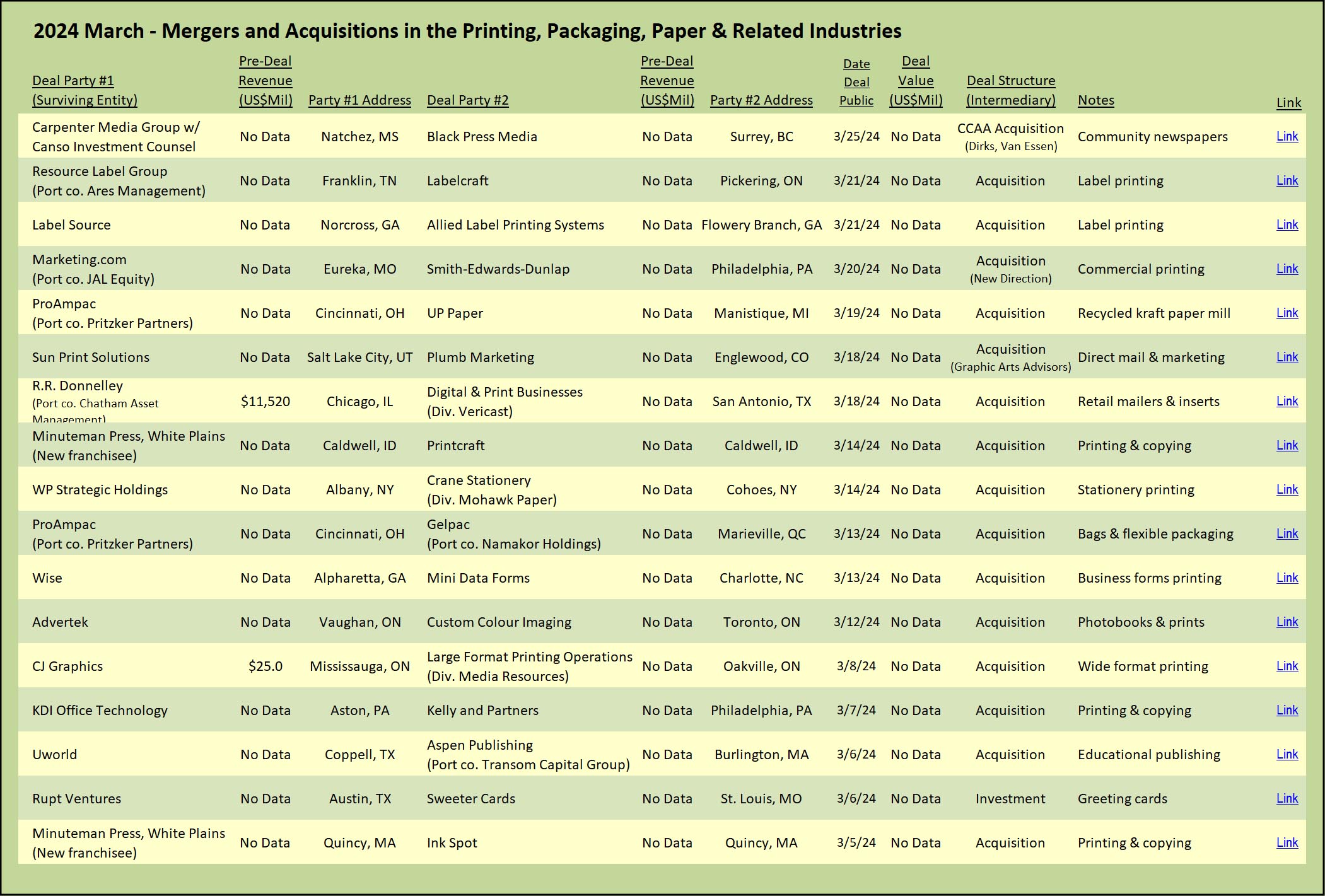
Chatham Asset Management, the owner of R.R. Donnelley (“RRD”), the country’s largest printing company, tried and failed last year to acquire the entirety of Vericast. Not to be denied, however, Chatham has now settled on a partial acquisition of its target. With the tenacity that has characterized Chatham Asset Management, the owner of RRD, in their pursuit of acquisition targets, Chatham persevered and has now successfully bit off a major chunk of Vericast which includes the legacy print and marketing business formerly known as Valassis. Chatham’s latest offer was under the RRD umbrella, the company they wrestled Atlas Holding to the mat to acquire. (For more, see The Target Report: Slugfest Breaks Out Over RR Donnelley – November 2021.)
In the Spring of 2023, Chatham submitted an offer to buy all of Vericast for $2.85 billion, reportedly an amount equal to Vericast’s debt at the time. It was a classic loan-to-own strategy: Chatham owned nearly half of Vericast’s debt, with first and second-lien positions in much of that debt.
The owner of Vericast, Ronald Perelman’s holding company MacAndrews & Forbes, turned down Chatham’s offer last year, despite Vericast’s precarious position with several tranches of high-interest loans due over the next four years, some of which were trading at 70 cents on the dollar. Perelman, one of the most famous buyout kings, known for his long history of acrimonious dealmaking (Revlon, Gillette, Sunbeam, Barkin, and many more) entered the printing industry in 2011 with the take-private acquisition of check printing company Harland Clarke and related entities. Harland Clarke subsequently acquired the retail insert company Valassis in 2013. In an attempt to shed its historical print-centric brand names, the company was rebranded in 2020 as Vericast.
Printing, Anyone?
RRD announced the acquisition of the “Vericast Digital Marketing & Technology business” with a long list of the services that will be offered: “display advertising, contextual targeting, connected TV, dynamic mobile, digital out of home, social media marketing, email marketing, local search, and zero-party data capture.”
In the segment of our business here at GAA in which we assist owners of commercial printing companies to buy, sell, and merge, we do find that there is convergence between the print marketing channel and digital marketing channels, so most of these services were certainly familiar as I attempted to figure out exactly what did RRD buy here? Admittedly, I had to look up what contextual targeting was (nothing fancy about this really, just putting ads on webpages where it makes sense, such as advertising for hammers if you are buying nails). I discovered that “connected TV” means you have a smart TV, or as in my case, a Roku box hooked up to an older large screen set. Display advertising, social media marketing, email marketing, and the others required no additional research.
Zero-party data capture was also a mystery, as I could not guess what or who is a “zero-party.” With a little bit of research, I now know that zero-party data is simply information that a consumer knowingly chooses to share with the advertiser through surveys, permission click-boxes, mobile apps, loyalty programs, and similar opt-in choices. Zero-party data is differentiated from first-party data (information from cookies that track your online activity), second-party data (your cookie-data has been sold to someone else), and third-party data (information that is aggregated and then sold in bulk by list companies).
Oh, and by the way, the RRD announcement briefly mentioned that the transaction also includes “Vericast’s print marketing business, including shared mail and free-standing inserts, as well as the digital and print coupon clearing business.” In other words, RRD has now acquired the Valassis business.
The King of Coupons
George Valassis emigrated from his native country of Greece at an early age. Born in 1929, he grew up in the time when radio and television were in the ascendency. Starting in the advertising business, he eventually was, however, drawn to the printing business, establishing Valassis Communications in 1970 as a small printing business based in Michigan. In short time, he shifted his focus to the growing coupon and direct marketing business.
Along the way, Valassis was acquired by Consolidated Press Holding (“CPH”), an Australian company. The company went public in 1992 and CPH divested its remaining shares in 1997. Valassis went on to acquire other familiar names in the direct marketing and coupon business, including Advo and Clipper Magazine, among others. Valassis also purchased coupon processing and clearing house NCH Marketing in 2003, effectively closing the coupon advertising loop with its advertisers, from delivery of printed flyers to reimbursement of redeemed coupons.
That little printing business eventually grew into the company that served 15,000 advertisers in the United States, Europe, Mexico, and Canada. Employees in 28 states and nine countries, supported by several geographically diverse printing plants, served up highly localized advertising. The presses churned out millions of freestanding inserts and coupon mailers, and consumed 170,000 tons of paper a year, with an annual capacity of 92 billion pages. When the Perelman-owned company came calling in 2013, the price tag was a mouthwatering $1.8 billion.
The Valassis freestanding insert and coupon business was a pioneer of managing information to provide highly localized printed pieces. Whether delivered in a newspaper or via the postal service, as is now more common due to the decline of local newspapers, those advertising circulars are customized to include advertising from grocery and other stores that are within reasonable distance of the recipients’ homes. Not quite personalized on a 1-to-1 basis, but revolutionary in its day.
As might be expected of a pioneering marketing company, Valassis was an early adopter of internet-based coupons. At the dawn of the internet age, in 1999, the company launched Save.com, an internet coupon website. However, the site was unable to gain sufficient critical mass to attract enough advertising and was shuttered in 2001. You might recognize the Save name, as it was recently resurrected for the printed advertising circular, replacing the RedPlum title that previously graced the cover sheet.
With the recent proliferation of mobile-based couponing that can be scanned or e-coupons that are checked off on a mobile-digital shopping list, consumers are no longer required to cut out coupons or print online coupons onto paper for redemption at the point of sale. No wonder that RRD was much more vociferous about the digital components of the business they purchased and downplayed the core print-based assets.
What is Left of Vericast?
Vericast did not entirely abandon the printing business with the sale of Valassis. Vericast is retaining its original core business, the Harland Clarke check printing business, as well as a financial solutions business. With the sale of the Valassis business, Harland Clarke sheds $1.2 billion of debt, greatly reducing its anticipated leverage and improving its expected cash flow.
The check printing business benefits from recurring long-term sticky customer relationships with financial institutions which outsource the check servicing business to Harland Clarke. Although the check printing business is clearly shrinking, the company believes that it can manage the long slow decline with cost savings, combined with price increases.
In an analysis that may seem counterintuitive about the check printing business, which everyone knows is in decline, the S&P Global Ratings company has upgraded its rating on Vericast’s debt. S&P forecasts that Vericast’s leverage will improve to a moderately-leveraged 5.0x by the end of 2024, which is down from its highly-leveraged mid-7x range before the transaction with RRD. S&P also forecasts that Vericast’s EBITDA margins will improve to 35% in 2024, much better than the company’s EBITDA margin of 19% in 2023 before the sale of the Valassis business.
View The Target Report online, complete with deal logs and source links for March 2024













Discussion
Join the discussion Sign In or Become a Member, doing so is simple and free